Software > OpenVMS Systems > Documentation > 82final > 6083 HP OpenVMS Systems Documentation |
HP Pascal for OpenVMS
|
| Previous | Contents | Index |
A D_floating-point value is represented by eight contiguous bytes. The bits are numbered from the right, 0 through 63, as shown in Figure A-4.
Figure A-4 D_floating-Point Data Representation
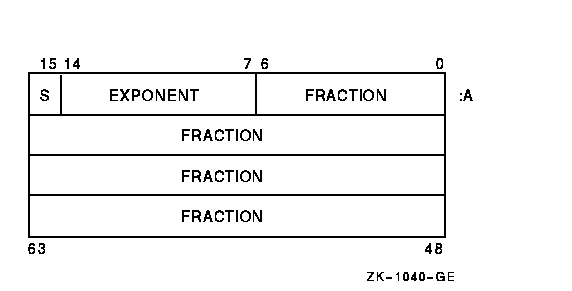
A D_floating-point value is specified by its address A, the address of the byte containing bit 0. The form of this value is identical to that of a F_floating-point value except for an additional 32 low-significance fraction bits. Within the fraction, bits of increasing significance are numbered 48 through 63, 32 through 47, 16 through 31, and 0 through 6.
A G_floating-point value is represented by eight contiguous bytes. The bits are numbered from the right, 0 through 63, as shown in Figure A-5.
Figure A-5 G_floating-Point Data Representation
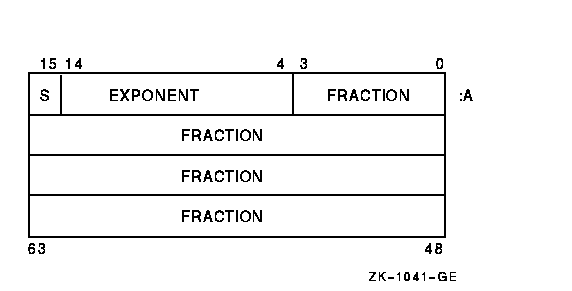
A G_floating-point value is specified by its address A, the address of the byte containing bit 0. The form of this value is sign magnitude as follows:
A T_floating-point value is represented by 8 contiguous bytes. The bits are numbered from the right 0 through 63, as shown in Figure A-6.
Figure A-6 T_floating-Point Data Representation
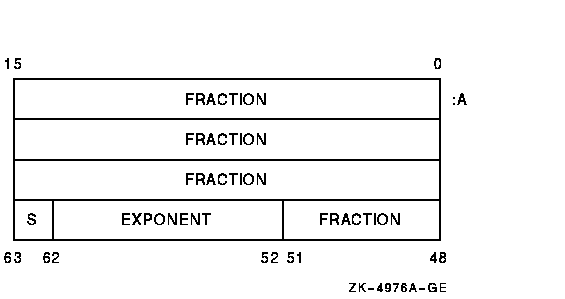
A T_floating-point value is specified by its address A, the address of the byte containing bit 0. The form of this value is sign magnitude as follows:
An H_floating-point value is represented by 16 contiguous bytes. The bits are numbered from the right 0 through 127, as shown in Figure A-7.
Figure A-7 H_floating-Point Data Representation
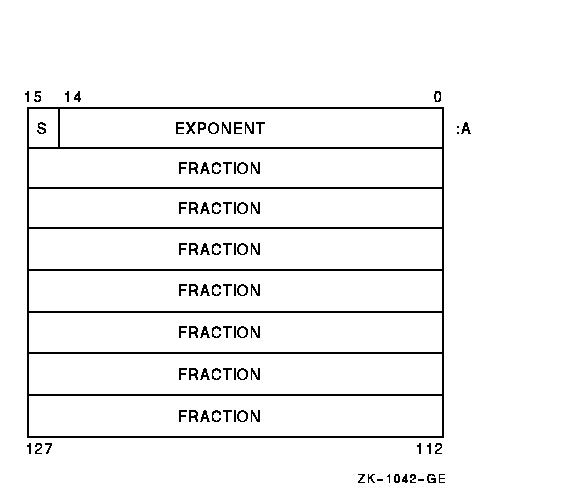
An H_floating-point value is specified by its address A, the address of the byte containing bit 0. The form of this value is sign magnitude as follows:
An X_floating-point value is represented by 16 contiguous bytes. The bits are numbered from the right 0 through 127, as shown in Figure A-8.
Figure A-8 X_floating-Point Data Representation
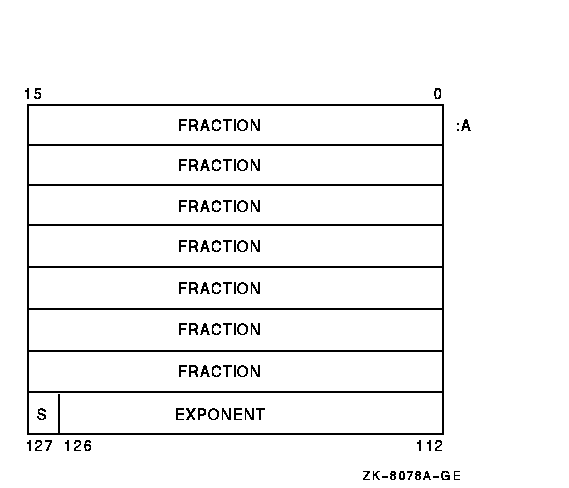
An X_floating-point value is specified by its address A, the address of the byte containing bit 0. The form of this value is sign magnitude as follows:
Each nonstatic data type has some storage associated with it, called the control part. Figure A-9 shows the layout of a control part of a nonstatic data type.
Figure A-9 Storage of Nonstatic Data Types
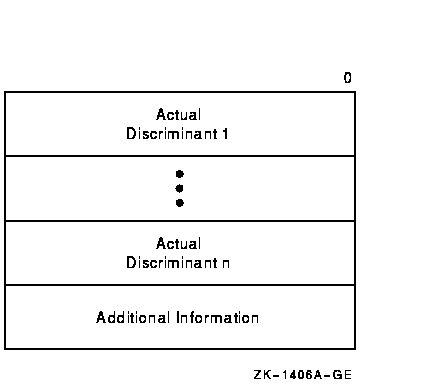
In the top portion of the control part, HP Pascal stores each actual discriminant of the schema type in a longword of storage. The additional information piece of the control part varies in content and size depending on the type specification, and can contain any of the following:
TYPE A_Char( x,y : CHAR ) = x..y; |
TYPE
My_Record( a, b : INTEGER ) = RECORD
f1 : STRING( a );
f2 : STRING( b );
END;
|
TYPE My_Subrange( a, b : INTEGER ) = a..a+b; |
TYPE Arr( a, b : INTEGER ) = ARRAY[a..b] OF REAL; |
The order of information and the content of the additional information section of the control part cannot be guaranteed. |
If you declare more than one variable of a discriminated schema type, each variable shares the information in the control part for that type.
When allocating storage for a variable of a nonstatic type, HP Pascal allocates a pointer part and a data part. HP Pascal allocates and initializes the pointer part (to point to the data part); you cannot access the pointer part in your program. HP Pascal associates each object with a control part according to its data type.
If the type of the object involves more than one nonstatic type, HP Pascal associates that object with all applicable control parts. Consider the following example:
TYPE
Sub_Range( a, b : INTEGER ) = a..b;
VAR {x requires information in two control parts:}
x : ARRAY[Sub_Range( i, j ), Sub_Range( k, l )] OF INTEGER;
|
Figure A-10 shows the layout for an object of a nonstatic type.
Figure A-10 Storage of Variables of Nonstatic Types

In Figure A-10, the pointer part is directly accessible by your program. The data part is allocated in heap when you use the NEW procedure. For example:
TYPE
dstr = STRING( I );
VAR
ptr : ^dstr;
{In the executable section:}
NEW( ptr );
|
You cannot create variables of undiscriminated types, but you can also show the representation for pointers to nonstatic types (except undiscriminated schema).
Figure A-11 shows the layout for a pointer to an undiscriminated schema type.
Figure A-11 Storage of Pointer Variables to Undiscriminated Schema Types
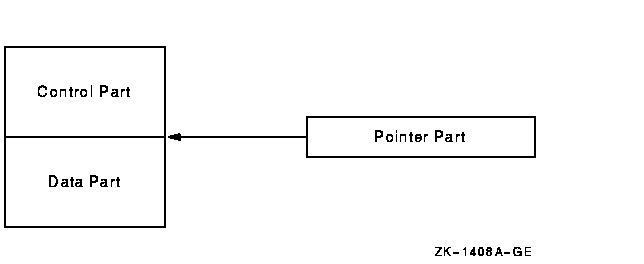
In Figure A-11, the control part and data part are allocated together by a call to the NEW procedure. Each object allocated this way has its own control part since the base type of the pointer is undiscriminated and does not have a control part. Consider the following example:
VAR
x, y, z : ^STRING;
{In the executable section:}
NEW( x, 10 ); {x has a control and data part}
y := x; {y points to same control and data part as x}
NEW( z, 10 ); {z has separate control and data parts}
|
Each variable created by NEW contains a unique control part attached to the data part.
If a record object contains a field of a nonstatic type, HP Pascal stores the field in one piece of storage within the record's storage (HP Pascal does not create a pointer part and a data part). HP Pascal determines the offset of the object by accessing the information in the control part of the field's data type and information in the control part of the record.
If you need to write portable code, you should not use the language features that are HP Pascal extensions. The following sections provide information on HP Pascal extensions:
Table B-1 summarizes the language features provided in HP Pascal that are not part of the unextended Pascal language definitions.
| Category | Extension |
|---|---|
|
Lexical and
syntactical extensions |
Reserved words: BREAK, CONTINUE, ERR, EXIT, MODULE, NEXT, OTHERWISE, REM, RETURN, VALUE, VARYING, %DESCR, %STDESCR, %IMMED, %REF, %INCLUDE, %TITLE, %SUBTITLE, %DICTIONARY, %IF, %ELIF, %ENDIF, %DEFINED, %ERROR, %WARN, %INFO, %MESSAGE, %ARCH_NAME, %SYSTEM_NAME, %SYSTEM_VERSION, %DATE, %TIME, %COMPILER_VERSION, %LINE, %FILE, %ROUTINE, %MODULE, %IDENT |
| Exponentiation operator (**) | |
| REM operator | |
| AND_THEN and OR_ELSE operators | |
| NOT IN operator | |
| Type cast operator (::) for variables and expressions | |
| Double quotation marks as string and character delimiters | |
| Escape sequences within double quotation marks | |
| %radix-specifier for binary, hexadecimal, and octal notation for integers, (#) radix-specifier for integers in bases 2 to 36 inclusive | |
| Double- and quadruple-precision real numbers | |
| Dollar sign ($) and underscore (_) characters in identifiers | |
| Identifiers that can begin with the dollar sign or underscore characters | |
| Alphanumeric strings for labels | |
| Extended syntax for inclusion of nonprinting characters in single-quoted character strings | |
| Compile-time constant expressions allowed anywhere a constant is allowed | |
| Constructors of structured types used anywhere in place of a constant of the structured type | |
| Attributes used with data items, routines, and compilation units | |
| Relaxed rules for assignment compatibility | |
| Structural compatibility enforced between actual and formal parameters | |
| ! for end-of-line comments | |
| Predefined types | ALFA, CARDINAL, CARDINAL16, C_STR_T, INTEGER_ADDRESS, CARDINAL32, INTEGER8, INTEGER16, INTEGER32, INTEGER64, INTSET, POINTER, UNIV_PTR, UNSIGNED8, UNSIGNED16, UNSIGNED32, UNSIGNED64, SINGLE (F_floating and S_floating), DOUBLE (D_floating, G_floating, and T_floating), QUADRUPLE (H_floating and X_floating), STRING, TIMESTAMP |
| VARYING OF CHAR structured type and concatenation operator for all strings | |
|
Predeclared
procedures |
ARGV, ASSERT, BARRIER, CLOSE, CREATE_DIRECTORY, DATE, DELETE, DELETE_FILE, ESTABLISH, EXTEND, FIND, FINDK, GETTIMESTAMP, HALT, LINELIMIT, LOCATE, OPEN, READV, REMOVE, RENAME_FILE, RESETK, REVERT, STLIMIT, TIME, TRUNCATE, UNLOCK, UPDATE, WRITEV GETTIMESTAMP |
|
Predeclared
functions |
Transfer functions: DBLE, INT, INT64, QUAD, ROUND64, SNGL, TRUNC, TRUNC64, UINT, UINT64, UROUND, UROUND64, UTRUNC, UTRUNC64 |
| Implicitly declared type-conversion and type-casting routines for predefined data types | |
| Dynamic allocation function: ADDR, ADDRESS, IADDRESS, IADDRESS64 | |
| Character-string functions: BIN, DEC, HEX, INDEX, LENGTH, OCT, PAD, STATUSV, SUBSTR, UDEC, GT, GE, LT, LG, EQ, NE | |
| Parameter functions: ARGUMENT, ARGUMENT_LIST_LENGTH, PRESENT | |
| Privileged routines: MFPR, MTPR | |
| Arithmetic functions: BITAND, BITNOT, BITOR, BITXOR, LSHFT, LSHIFT, MIN, MAX, RANDOM, RSHFT, RSHIFT, SEED, UAND, UNOT, UOR, UXOR, XOR | |
| Allocation size functions: SIZE, SIZEOF, NEXT, BITSIZE, BITNEXT | |
| Ordered sequence of values functions: FIRST, FIRSTOF, HBOUND, IN_RANGE, LAST, LASTOF, LBOUND | |
| Low-level interlocked functions: ADD_ATOMIC, ADD_INTERLOCKED, AND_ATOMIC, CLEAR_INTERLOCKED, FIND_FIRST_BIT_CLEAR, FIND_FIRST_BIT_SET, FIND_MEMBER, FIND_NONMEMBER, OR_ATOMIC, SET_INTERLOCKED | |
| Null-terminated string functions: C_STR, MALLOC_C_STR, PAS_STR, PAS_STRCPY | |
| I/O functions: STATUS, UFB | |
| Field position functions: BIT_OFFSET, BYTE_OFFSET | |
| Additional functions: ARGC, CARD, CLOCK, EXPO, UNDEFINED, ZERO, DATE, TIME, UPPER, LOWER, SYSCLOCK, WALLCLOCK | |
|
READ, READLN,
WRITE, WRITELN extensions |
Parameters of character-string and enumerated types for READ and READLN
Parameters of enumerated types for WRITE and WRITELN Prompting at the terminal with a WRITE/READ orWRITE/READLN sequence Optional carriage-control specification for text files with WRITE and WRITELN Optional radix specification for READ and READLN Optional radix specification for WRITE and WRITELN |
| Extended I/O capabilities |
Direct access and relative file organization
Keyed access and indexed file organization Optional second parameter to RESET, REWRITE, and EXTEND for specifying a file name |
| Declarations | Declaration and definition sections that can appear more than once and in any order |
| Initialization of variables, types, and record fields in VAR and TYPE sections of any program, module, procedure, or function | |
| Schema types | |
| VALUE initialization section | |
| OTHERWISE clause in variant records | |
| Ranges in variant label lists | |
| Statements | OTHERWISE clause in CASE statement |
| Ranges in CASE label lists | |
| BREAK, CONTINUE, EXIT, NEXT, and RETURN statements | |
| FOR statement with SET iterations | |
|
Procedures and
functions |
Functions that return values of structured types (other than file types) |
| Functions called as procedures | |
| External procedure and function declarations | |
| Default values for formal parameters | |
| Nonpositional parameter passing | |
| Extended mechanism specifiers and parameter-passing attributes for passing parameters to external procedures and functions: %IMMED, %REF, %DESCR, %STDESCR, IMMEDIATE, REFERENCE, CLASS_S, CLASS_A, CLASS_NCA | |
| Compilation | MODULE capability for combining declarations and definitions to be compiled independently from the main program |
| ENVIRONMENT and INHERIT attributes to control independent compilation | |
| Module initialization and finalization |
Table B-2 summarizes the language features provided in HP Pascal that are not part of the Extended Pascal language definitions.
| Category | Extension |
|---|---|
|
Lexical and
syntactical extensions |
Reserved words: BREAK, CONTINUE, ERR, EXIT, NEXT, REM, RETURN, VARYING, %DESCR, %STDESCR, %IMMED, %REF, %INCLUDE, %TITLE, %SUBTITLE, %DICTIONARY, %DICTIONARY, %IF, %ELIF, %ENDIF, %DEFINED, %ERROR, %WARN, %INFO, %MESSAGE, %ARCH_NAME, %SYSTEM_NAME, %SYSTEM_VERSION, %DATE, %TIME, %COMPILER_VERSION, %LINE, %FILE, %ROUTINE, %MODULE, %IDENT |
| REM operator | |
| NOT IN operator | |
| Type cast operator (::) for variables and expressions | |
| "%radix-specifier number" form for binary, hexadecimal, and octal notation for integers | |
| Alphanumeric strings for labels | |
| Double- and quadruple-precision real numbers | |
| Identifiers can contain the dollar sign ($) character | |
| Identifiers can begin with the dollar sign character and the underscore character | |
| Double quotation marks as string and character delimiters | |
| Escape sequences within double quotation marks | |
| Labels can be alphanumeric strings | |
| Extended syntax for inclusion of nonprinting characters in single-quoted character strings | |
| Parenthetical form ((constructor)) for constructors of structured types, used anywhere in place of a constant of the structured type | |
| Attributes | |
| Relaxed rules for assignment compatibility | |
| Structural compatibility enforced between actual and formal parameters | |
| ! for end-of-line comments | |
| Predefined types | ALFA, C_STR_T, CARDINAL, CARDINAL16, CARDINAL32, INTEGER8, INTEGER16, INTEGER32, INTEGER64, INTSET, POINTER, UNIV_PTR, UNSIGNED8, UNSIGNED16, UNSIGNED32, UNSIGNED64, SINGLE (F_floating and S_floating), DOUBLE (D_floating, G_floating, and T_floating), QUADRUPLE (H_floating and X_floating) |
| VARYING OF CHAR structured type and concatenation operator for all strings | |
|
Predeclared
procedures |
ARGV, ASSERT, BARRIER, CLOSE, CREATE_DIRECTORY, DATE, DELETE, DELETE_FILE, ESTABLISH, FIND, FINDK, LINELIMIT, LOCATE, NULL, OPEN, READV, REMOVE, RENAME_FILE, RESETK, REVERT, STLIMIT, TIME, TRUNCATE, UNLOCK, UPDATE, WRITEV |
|
Predeclared
functions |
Transfer functions: DBLE, INT, INT64, QUAD, ROUND64, SNGL, TRUNC, TRUNC64, UINT, UINT64, UROUND, UROUND64, UTRUNC, UTRUNC64 |
| Implicitly declared type-conversion and type-casting routines for predefined data types | |
| Dynamic allocation function: ADDR, ADDRESS, IADDRESS, IADDRESS64 | |
| Character-string functions: BIN, DEC, HEX, OCT, PAD, STATUSV, UDEC | |
| Parameter functions: ARGUMENT, ARGUMENT_LIST_LENGTH, PRESENT | |
| Arithmetic functions: BITAND, BITNOT, BITOR, BITXOR, LSHFT, LSHIFT, RANDOM, RSHFT, RSHIFT, SEED, UAND, UNOT, UOR, UXOR, XOR, MIN, MAX | |
| Allocation size functions: SIZE, SIZEOF, NEXT, BITSIZE, BITNEXT | |
| Ordered sequence of values functions: FIRST, FIRSTOF, HBOUND, IN_RANGE, LAST, LASTOF, LBOUND | |
| Low-level interlocked functions: ADD_ATOMIC, ADD_INTERLOCKED, AND_ATOMIC, CLEAR_INTERLOCKED, FIND_FIRST_BIT_CLEAR, FIND_FIRST_BIT_SET, FIND_MEMBER, FIND_NONMEMBER, OR_ATOMIC, SET_INTERLOCKED | |
| Privileged routines: MTPR, MFPR | |
| I/O functions: STATUS, UFB | |
| Null-terminated string functions: C_STR, MALLOC_C_STR, PAS_STR, PAS_STRCPY | |
| Field position functions: BIT_OFFSET, BYTE_OFFSET | |
| Additional predeclared functions: ARGC, CLOCK, EXPO, LOWER, SYSCLOCK, UNDEFINED, UPPER, WALLCLOCK, ZERO | |
|
READ, READLN,
WRITE, WRITELN extensions |
Parameters of enumerated types for READ and READLN
Parameters of enumerated types for WRITE and WRITELN Prompting at the terminal with a WRITE/READ orWRITE/READLN sequence Optional carriage-control specification for text files with WRITE and WRITELN Optional radix specification for READ and READLN Optional radix specification for WRITE and WRITELN |
| Extended I/O capabilities |
Direct access and relative file organization
Keyed access and indexed file organization Optional second parameter to RESET, REWRITE, and EXTEND for specifying a file name |
| Declarations | VALUE initialization section |
| Statements | BREAK, CONTINUE, EXIT, NEXT, and RETURN statements |
| Procedures and functions |
Functions called as procedures
External procedure and function declarations Default values for formal parameters Nonpositional parameter passing Extended mechanism specifiers and parameter-passing attributes for passing parameters to external procedures and functions: %IMMED, %REF, %DESCR, %STDESCR, IMMEDIATE, REFERENCE, CLASS_S, CLASS_A, CLASS_NCA |
| Compilation | MODULE syntax differs from the syntax provided by Extended Pascal |
| ENVIRONMENT and INHERIT attributes to control independent compilation |
| Previous | Next | Contents | Index |